Making Your Own Shellac From Scratch
For more information on finishes, see our beginner site Common Woodworking.
Making shellac is a simple process whereby we dissolve the flakes of shellac we buy into 190-proof denatured alcohol which we either buy through license here in the UK or we use Methylated spirits, which is denatured alcohol with an added violet colouring and any of a number of other additives that make the Meths undrinkable and even poisonous to prevent the misuse of it as an alternative cheap intoxicant. Methylated spirits and Denatured Alcohol are one and the same Ethanol, which is used universally as an industrial solvent for creating products used in finishing, dyes and more and also for making and thinning finishes like shellac. The main additive used in Methylated Spirits is Methanol, hence the name Methylated Sprits. Adding methanol to denatured alcohol doesn’t alter the chemical properties of the alcohol apparently.
I use a glass jar or a plastic bottle to mix my shellac in but it has a shelf life so mix only what you will use in a few months. No more than six I would say. Whatever you mix, make sure there is enough room for the shellac flakes plus some for shaking during dissolution.
Denatured alcohol – Methylated Sprits is highly flammable
Denatured alcohol in any form and with any additive that makes it Methylated spirits is highly flammable. Never try heating it on an open flame or even have the product near any kind of direct or indirect open flame.
You can buy shellac made ready for dissolving in different forms such as pearls, flakes or pre-crushed flakes. The shellac can be in different forms depending on what you want. In its natural condition, shellac is a dark amber coloured. Sometimes we want the dark amber and other times, in my case most of the time, we want the shellac bleached and dewaxed. That being so, we buy bleached and dewaxed shellac which simply means what it says. The shellac is less waxy and can be colourless or clear. French polishers use both the natural colour of the shellac and blond or clear and then also degrees of colour for their work and this is usually governed by the colour of the wood they are polishing. Light woods such as maple or cherry will turn amber with full coloured shellac flakes. If you do not want this as a colour you must use bleached shellac.
Add the shellac flakes or pearls into the liquid and shake regularly to agitate the mixture, which speeds up the dissolution process exponentially. Leave it stand long enough between shakes, about half an hour or so usually. Depending on the conditions of the shellac manufacture, the shellac may need straining through cloth to remove contaminants.
You can make different cuts to suit your needs. I generally use premixed shellac for everyday work, but there is no doubt that home mixed shellac is indeed best. Whether you make your own or buy it ready mixed, shellac can be thick or thin and this depends on the ratio of denatured alcohol to the pound weight of shellac used. Hence we use the term ‘cut’ because when we mix shellac with the solvent we create different viscosities to work the shellac at different stages in our work. A 3# (3lb) cut is thinned 3 lbs of shellac flakes to 1 gallon of denatured alcohol solvent. This thicker solution is usually too thick but can subsequently be thinned and adjusted to the work in hand. A more general cut is a 1# cut. I find it satisfactory to make a heavier mix and thin down as needed but a 1# cut is good for padding on and a 2# cut is good for brushing on.
Remember to use dewaxed shellac as a primer coat painted finishes as the paint will not adhere well to waxy shellac.
Mixing Your Own Shellac
Pound cuts seems a little archaic when most of the world uses a metric system of weights and measures and perhaps we should simply go by quantity ratios of liquid to weight or measure quantity by volume. It’s not a critical thing, in fact it’s fairly open to do that or whatever you want. Here in the UK we generally mix 250g of shellac flakes to a litre of Methylated spirits. You then add additional flakes or meths to thicken or thin the viscosity to suit the task. My usual is to mix a heavier mix and then thin to task or cut the thicker mix and rebottle in different strengths. That way you have no down time waiting for shellac flakes to dissolve.
Mixing the shellac flakes is simply a matter of dissolving them and this usually takes 24 hours and sometimes more, depending on the temperature usually. If it’s too cold it takes longer and you can use warm water baths to increase the temperature or other heat sources such as radiators. Remember, no open flames of any kind or hot plates. This stuff is as said highly flammable. You can stir the flakes or shake them in the solution periodically. I shake them generally and then let it stand to express air in the mix before I use it. I usually shake whenever I remember, but generally every half hour works well. This will halve the dissolution time.
Don’t get too caught up in the thickness of the shellac too much. You can always readily thicken or thin your product and you can always use whatever you mix. If it’s too thick it’s more difficult to use that’s all.
Today I mixed some shellac. A 21/2# cut. I wanted to take the steps you might take so I ordered Liberon Shellac Flakes online via Amazon and then some denatured alcohol in the form of Methylated Spirits from another online supplier. The flakes I ordered were dewaxed blond shellac flakes that basically give me two things in one – one, the naturally occurring wax is drastically reduced allowing me to use it under other finishes and, two, the removal or lightness of colour means I can use it on all woods without changing the colour of the wood. Especially is this important on light coloured and white woods If I do need to change colour I prefer to use dyes on the wood and not in the finish.
Some people say not to shake but stir; I do both and have done for years. What I do not generally do is shake immediately before use. If you shake, leave it to stand for a minute before using to allow bubble to dissipate and let the mix settle.
Ready to Use Products Might be Deceptive
Many companies make products from shellac and describe them as something different to one another. Spirit sanding sealer, sanding sealer and sealer and sand or sanding coat are usually one and the same in that they are shellac flakes diluted in denatured alcohol. The difference can be the viscosity of the liquid. Thin or thick means that one will flow more quickly and end up with a thinner coat with quicker drying and thicker residue after evaporation, which is the actual shellac coat left after drying and curing. You don’t need a thick coat for a sealer so a thinner coat works well. After sanding the surface will feel super smooth. This is the nature and property or characteristic of shellac. This coat will seal the surface and freeze any surface (end-grain) fibres that might be detached or what we call ‘open’ at one end. This initial application will usually raise the grain slightly, which is actually something we want to happen now rather than later. Subsequent coats of shellac, varnish or other finish types can be built on this foundation and they generally will not raise the grain further.
Let’s look at Other Products
It’s not unusual to see a product line made by finish manufacturers that give the impression you might need two, three or more products to develop and establish a good finish on a project. Often they start with sanding sealer followed by some kind of body-build shellac as another and then perhaps a product entitled French Polish as yet another. All of these products simply put are shellac based and thinned or thickened by more or less flakes of shellac or denatured alcohol .Other names you will come across are button polish, button shellac, amber shellac, bleached shellac, dewaxed shellac and others are names that might further confuse the issue. In general these are all quite simply shellac-based products. Bleached shellac as an instance is simply shellac which has the naturally occurring amber brown colour bleached out to make it clear when applied and dried. Other colours such as blonde, amber shellac have only part of the colour removed and are usually made to a distributors specs to supply us with shades we choose according to the approximate shade we want for particular pieces we are working on. Depending on the company, many colours are available, but, if the shellac you have is dark and needs adjustment you can create your own changes by adding clear shellac to lighten the colour. All shellac-based products can generally be mixed.
This mix looks like its ready after two hours but don’t be deceived. Keep agitating for 24 hours. the suspension of flakes may not be visible. Shaking helps to disperse equality throughout the solution and the end result is completely dissolved shellac.
As the colour of shellac is often different between manufacturers and distributors, it’s best to look at the products suppliers description and colour charts. Button shellac is usually a deeper, richer, brown shellac used for joinery, panelling and furniture making and restoration where darker timbers were used.
White polish on the other hand is a shellac made from colourless translucent lac that dries clear and we use this when we don’t want to change the colour of the wood being treated or woods that are naturally white or blond such as sycamore, maple, white ash, alder and birch. The colour range is quite diverse ranging from garnet, ruby, orange, amber, light amber, brown, rust and many more.
Surface Coverage
As a general guide, I find that surface coverage is usually about one litre of shellac to 10 square metres of surface. Thicker solutions can mean less coats, especially if spraying on the finish as a heavier coat.
Cost of Self Mixes
It may or may not prove cheaper or more convenient to make your own shellac from scratch but what you do get is a known product. Using exactly denatured alcohol or methylated spirits with shellac flakes means you are getting what you put into it. Buying brand names means they may well have added other additives to the denatured alcohol that they feel improve the drying qualities or, more importantly to them, the shelf life, which they want to be as long as possible because of stock-in-store quality. Buying as I did I ended up paying a little more than buying a premix, but then I made my mix thicker for further cutting with DA as needed. All in all I probably ended up at the same price. I have found that the self mix dries quicker and applies better. The overall appearance to me seems better too.



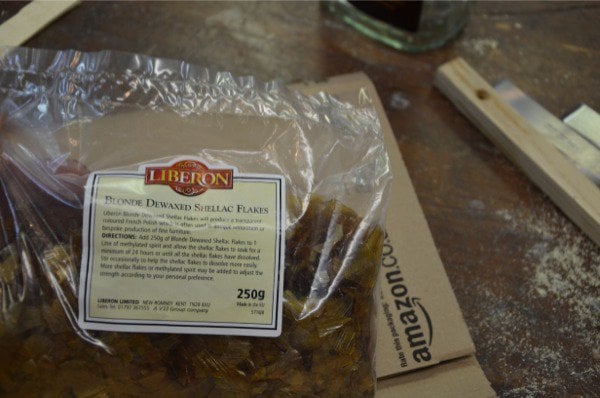
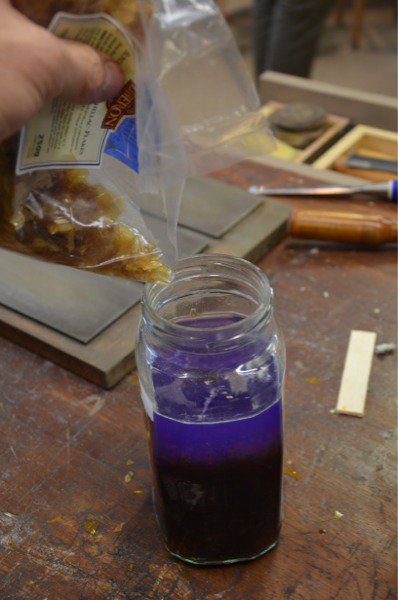
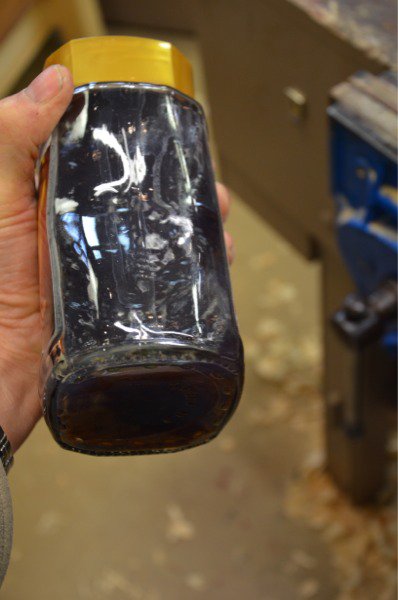
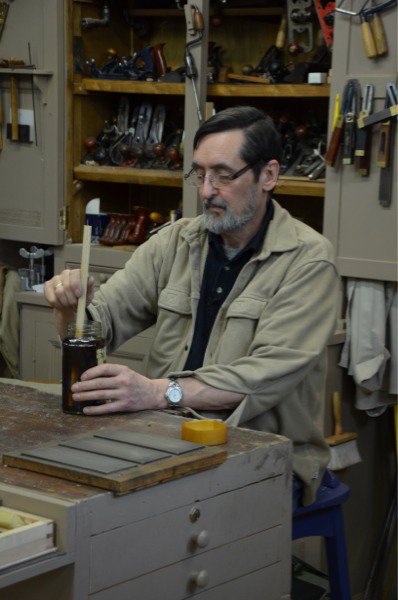
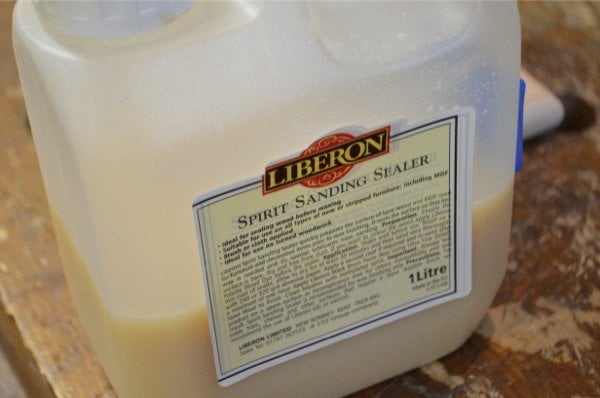
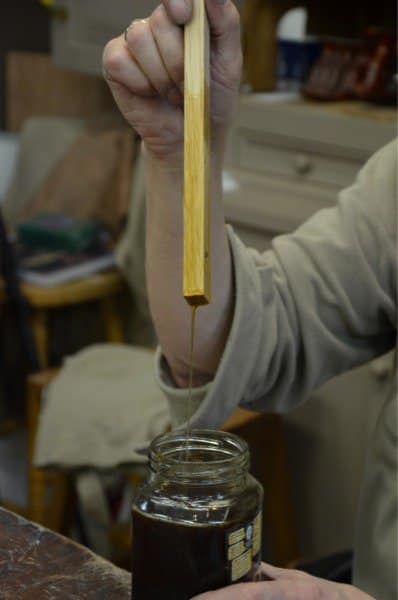
I just wanted to add a small “discovery” I made regarding adding color to shellac.
I’ve read your posts about using leather dye to tint the shellac prior to application. I’ve also discovered, after searching various local stores, that leather dye has been banned for sale in the state of California. :-/ Something about air quality control.
I wanted to use an alcohol-based leather dye, since I understand that a water-base and shellac don’t coexist well, and an oil-base I’m not so sure of either. While looking for an alternative, I discovered alcohol inks. They are available at arts-and-crafts stores. There are tons of colors, too. I bought a 3-pack of “earth-tones” for only 6 dollars! They come in little bottles but a few drops go a long way. I have yet to experiment with different color combo’s, but the inks mix with shellac perfectly. And they’re fairly low-toxic too. A couple links:
What I used:
http://rangerink.com/?product=tim-holtz%C2%AE-adirondack%C2%AE-alcohol-inks
This brand has a wider range of color tones:
http://www.spectrumnoir.com/the-spectrum-noir-range/
There is a brand of liquor/spirits in the US that goes by the name of Everclear which is 190 proof. The cost varies but it usually goes for about $20 for a 750ml bottle. Legal, much safer, moonshine.
I use 190 proof ethanol too, but because it’s harder to come by I use it mainly when I French Polish. I do that mostly to minimize my exposure to the poisons they put in denatured alcohol. French polishing is more time-consuming so you have those vapors “in-your -face” for longer periods. And then you might be huffin’ and puffin’ too because it takes more elbow grease than say brushing. I work more peacefully with the pure stuff. But it’s more than that really. It’s a real joy to smell, especially after the shellac mix has “fermented” a couple days or more 🙂 It smells delicious! Very organic, and those vapors are generally not bad for your health.
From my research of MSDS sheets of several DA’s available in the U.S., I’ve found the “safest” one (and the only one I use) is the Klean-Strip Green stuff. It’s promised to be at least 90% ethanol, with the remaining percentage denaturants (and water). That’s about as good as it gets. The Klean-Strip in the blue can has a large % of methanol (like 30 or 40% I think?). Not good. I wouldn’t use that stuff if you gave it to me.
Very helpful Juan, it’s helpful to pass on thoughts and ideas this way. Thanks for the input.
For anyone in France, the clear 95% ABV (190 proof US) ‘Alcool ménager’ from supermarkets works very well for shellac and is around 3 to 5 euros a litre.
Hello,
thanks, very difficult to find what Paul describes ( not difficult but expensive, very expensive!!)
Cyrille
Paul,
If flakes have been left unmixed, then they clump. Can the purchased flakes still be dissolved and used? Asked another way, if you purchase flakes and do not use them timely, do the flakes go bad?
Always add the flakes to the DA as pour into flakes causes unnecessary clumping. Sometimes they will clump in the bottom of the DA if you pour too fast and even if you don’t. If that happens you must stir to help the clumps dissolve. if moisture has been allowed into the stored shellac it will affect the shellac and may prevent the finished shellac from drying. It’s best to double bag what you buy. In other words when your flakes arrive add them to another sealable zip-lok bag. Flakes do go bad.
From the photos it looks like you have used alcohol with violet colorant added. Does it evaporate during drying together with alcohol? Or does it tint the resulting finish?
The colour makes no noticeable difference to the final finish. Painted on glass, the two halves look identical. I did just post a blog on this to help see what I mean.
Paul I would like to get your input. When I mix my own shellac I grind the flakes in a coffee grinder to fine powder and once mixed with metho it instantly dissolves therefore saving a 24hr wait period. Even though I haven’t had any issues on a first coat of a 1pound cut but have had issues of a second coat. It became sticker and difficult to brush once applied over the first coat, I diluted it even further to a half pound cut and still had the same problem. Even though I’m using shellac as a sealer I would like to try and use it as a finish with multiple coat build ups.
Hi the new coat is melting the last coat. when applied with a rubber oil is put onto the rubbers face this works I don’t want explain why, ( its long ish) but you might try putting a few drops of oil on the one side of the brush after charging/ loading with shellac and applying shellac oil face down. Don’t know if this would work but it might.
We should use the right international terminology here, Bill. You and I know that a rubber is a pad of cotton, wool gauze or lint-free material, but in the US and other countries it is a condom or contraceptive sheath.
Whereas indeed we do add a couple of drops of mineral oil to the pad to prevent the pad from dragging the finish. This leaves the French polish streaky as the oil and the shellac reflect differently. Additional work will remove streaking using the pad but I am certain adding oil to brush will not work in the same way I am afraid.
How do you take the colour of of orange shellac is there a simple bleaching process
I have never done this I have always bought blond, bleached and dewaxed shellac or flakes.
My dad dissolved the flakes in method then took one part of this plus one part bleach taking this then added one part with one part vinegar. Then was in clean.water then dry it. Then rediscover in metho. It worked.
I use the 99% Isopropranol Alcohol for dissolving Shellac. The auction site for 5 litres. It supposedly flashes off slower than Ethanol but the difference seems to be miniscule. I’ve never had problems French Polishing with it.
For brushing I add a few drops of Spike Oil of Lavender per small glass that acts as a retarder, smells nice too!
You can do a lot with tinting Shellac. There are the natural shellac colours but you can also add things like Alkanet. Button polish + Alkanet on Walnut can give a great warmth to the wood. Put enough on and it almost turns it into Rosewood!
Hi Michael. Can you please tell a little more about alkanet in shellac? I googled and there isn’t much info out there. The photos I’ve seen of alkanet on gun stocks look very nice. Where do you buy your alkanet, and in what form? Thanks!
Can I use this ethyl alcohol to dissolve and as a solvent in making my own shellac plz respond is %100 ethyl alcohol food grade?
It will dissolve shellac and it evaporates like denatured alcohol but I have never used it so can’t say. Why not just go for denatured alcohol or meths?
Is all the purple methylated spirit mineralised? I’ve purchased two 500ml bottles one says mineralised the other doesnt. One bottle that doesn’t states it use for French polishing.
Thanks
I don’t know where you reside Adam but the formula for ‘Methylated Spirits’ was changed sometime in 2013. Out has gone the small percentage of Methanol, which is good news.
In has come in a small percentage of Isopropanol and MEK. It’s still 90% + Ethanol (as it always was in the UK). I think the formula has been standardised for the whole of the EU.
The contents of denatured alcohol elsewhere in the world is likely different. Some may contain large percentages of Methanol. Read the MSDS.
The first picture in this article is one of mine, my dirty bench, my tail vice and my meths and flakes.
Would storing mixed shellac in the fridge lengthen its shelf life?
I don’t know, Heather. I never keep more than a six month supply on hand and shellac does last that long so it’s enough for me as fresh shellac is best anyway.
Very informative. I was searching every time unit converter to find the ratio. But your mixing information is way simple.
Please one query can we add color to shellac mix?
Hoping to hear you soon.
Regards
There is an interesting YouTube video on mixing shellac flakes. Search for “easy electric shellac mixer”.
What is the shelf life of Shellac flakes?
Flakes indefinite, mixed, ready to use 6-8 months.
hello, sorry to trouble you but I have come across your post as I live in Australia and was trying to find where I could buy Straw Hat Varnish which is used in printmaking. However, it can be bought in the UK but frustratingly cannot find this product in Australia. ( Postage is very expensive as it is considered a highly flammable liquid to send half way around the world). However, I looked up the ingredients and it seems to be basically a shellac varnish. Is there any particular ratio, say between shellac and meth spirits, to produce a varnish that is similar to Straw Hat Varnish?
I am presuming it is a thin varnish rather than a thick varnish.
Thank you.
All the best. NN.
P.S. if you are ever interested I can at some time explain what it is used for in etching.
Very informative you always learn. I have been French polisher for 45 years and I do not think French polish has a shelf life if anything it improves with age.
White polish is clear French polish with whiting mixed in.
Jacob